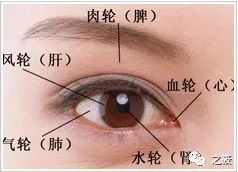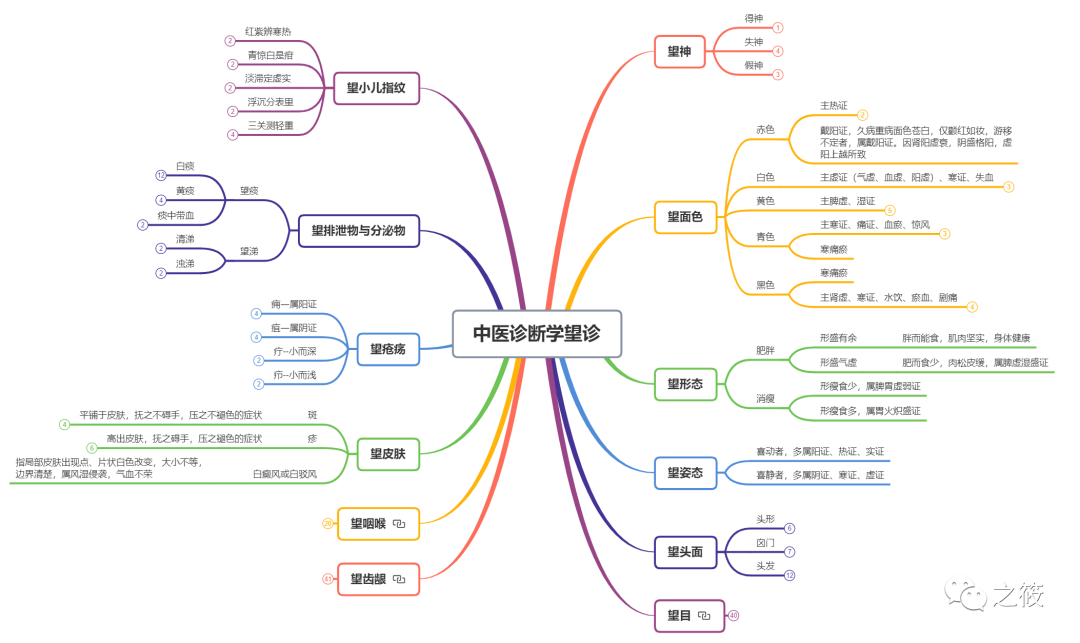Click the blue part to follow us
················ ················
informal essay
················ ················
Traditional Chinese Medicine (TCM) Observational Diagnosis
“Notes Compilation”
Observing the Spirit
(1) Normal Spirit (commonly seen in healthy individuals) Clinical manifestations: Clear consciousness, coherent speech, rosy complexion, subtle expressions, natural demeanor, bright and lively eyes, responsive, agile movements, steady breathing, and well-toned muscles. Clinical significance: Indicates abundant essence and qi, a healthy body and vibrant spirit, typical of a healthy person. If there is illness, it suggests that the essence and qi are not depleted, the illness is mild and easily treatable, with a good prognosis.
(2) Loss of Spirit 1. Essence deficiency and spirit decline (1) Clinical manifestations: Mental fatigue, possibly leading to confusion, low voice, pale complexion, dull and exposed expressions, dull and lifeless eyes, sluggish response, difficult movements, weak or rapid breathing, emaciation, and even severe weight loss. (2) Clinical significance: Indicates severe damage to essence and qi, functional decline, commonly seen in chronic illness, with a poor prognosis. 2. Excessive pathogenic factors causing chaotic spirit (1) Clinical manifestations: High fever and agitation, limb convulsions, or confusion and delirium, grasping at clothing or air, or sudden collapse and confusion, clenched hands, and tight jaw, etc. (2) Clinical significance: Indicates excessive pathogenic qi, heat disturbing the spirit, severe functional impairment, commonly seen in acute patients with more severe conditions.
(3) False Spirit In patients with chronic or severe illness who are in a state of spirit loss, there may suddenly appear some temporary “improvement” in spirit that is deceptive. (1) Clinical manifestations: Previously confused or extremely fatigued, suddenly appearing to be clear-minded, wanting to see relatives, or talking incessantly, but feeling restless; previously dull complexion suddenly showing flushed cheeks; previously dull eyes suddenly brightening; previously unable to move, suddenly wanting to get up and move, but unable to do so; previously having no appetite and unable to eat, suddenly craving food, and even overeating, etc. (2) Clinical significance: Indicates extreme depletion of organ essence and qi, righteous qi about to collapse, yin failing to restrain yang, and false yang escaping outward, yin and yang about to separate, indicating critical illness, often a sign of impending death in severely ill patients.
····························· ·····························
Observing Complexion
(1) Normal and Pathological Colors 1. Normal Color Normal complexion is characterized by slightly yellow and rosy, bright and moist. It is divided into main color and guest color. 2. Pathological Color The color of the face during disease states. Its characteristics are dullness and exposure.
(2) Five Colors Indicating Disease
1. Red: Indicates heat syndrome, also seen in Yang Deficiency syndrome. A fully flushed face indicates a real heat syndrome. Flushed cheeks in the afternoon indicate Yin Deficiency syndrome. A pale face in chronic severe illness with only flushed cheeks indicates Yang Deficiency syndrome, due to kidney Yang deficiency, Yin excess restraining Yang, and false Yang escaping.
2. White: Indicates deficiency syndrome (Qi deficiency, blood deficiency, Yang deficiency), cold syndrome, or blood loss. A pale complexion indicates blood deficiency or blood loss syndrome. A white complexion indicates Yang deficiency syndrome; if accompanied by floating symptoms, it indicates Yang deficiency with water retention. A pale complexion indicates sudden loss of Yang qi, sudden loss of qi and blood, or internal excess of Yin cold. 3. Yellow: Indicates spleen deficiency and dampness. (1) Pale yellow and dry complexion indicates withered yellow, indicating spleen and stomach qi deficiency. (2) Pale yellow and floating complexion indicates yellow and fat, indicating spleen deficiency with damp accumulation. (3) Jaundice: Refers to the entire face and body turning yellow. If the yellow is bright like orange peel, it indicates Yang jaundice, indicating damp-heat syndrome; if the face is dark yellow like smoke, it indicates Yin jaundice, indicating cold damp syndrome.
4. Blue: Indicates cold syndrome, pain syndrome, blood stasis, or convulsions. It is caused by obstruction of qi and blood, and meridian stasis. A pale blue or dark blue complexion indicates cold syndrome, often accompanied by severe pain. A gray-blue complexion with cyanotic lips indicates blood stasis in the heart meridian, often accompanied by chest pain. In children with high fever, a blue color between the eyebrows, on the nose, and around the lips indicates heat closing the spirit, a precursor to convulsions. 5. Black: Indicates kidney deficiency, cold syndrome, water retention, blood stasis, or severe pain. (1) A dark black complexion often indicates kidney Yang deficiency. (2) A dry black complexion often indicates kidney Yin deficiency. (3) Black around the eyes indicates kidney deficiency with water retention or cold dampness. (4) A dark black complexion with rough skin indicates long-term blood stasis.
····························· ·····························
Observing Body Shape
(1) Observing Body Type Obesity: Weight exceeding the normal standard by 20%. Characterized by a round head, short and thick neck, broad shoulders, thick and short chest, and a large belly. A healthy obese person has a strong appetite and firm muscles, indicating excessive form with sufficient energy. An obese person with a poor appetite and loose flesh indicates excessive form with qi deficiency, belonging to spleen deficiency with damp accumulation syndrome. Emaciation: Significant weight loss, more than 10% below the standard weight. A thin body with poor appetite indicates spleen and stomach weakness syndrome. A thin body with a good appetite indicates excessive stomach fire syndrome.
(2) Observing Posture: Active individuals often belong to Yang syndrome, heat syndrome, or excess syndrome. Those who prefer stillness often belong to Yin syndrome, cold syndrome, or deficiency syndrome.
····························· ·····························
Observing the Head, Face, and Features
(1) Observing the Head 1. Head Shape (1) Large head: Indicates congenital insufficiency, kidney essence deficiency, and water retention in the brain. (2) Small head: Due to insufficient kidney essence and poor cranial development. (3) Square head: Indicates congenital insufficiency and poor postnatal nourishment, leading to poor cranial development. 2. Fontanelle (1) Bulging Fontanelle: Indicates a solid condition, often due to warm disease fire attacking upward, or brain marrow disease, or water retention in the brain. (2) Sunken Fontanelle: Indicates a deficiency condition, due to vomiting and diarrhea damaging fluids, insufficient qi and blood, and congenital essence deficiency, leading to insufficient brain marrow. (3) Delayed Closure of Fontanelle: Indicates insufficient kidney qi and poor development, often seen in children with rickets, often accompanied by “Five Soft” (soft head, soft neck, soft hands and feet, soft muscles, soft mouth), “Five Delays” (delayed standing, walking, teething, speaking) and other symptoms.
3. Hair: Yellow hair indicates dry, sparse, and easily falling hair. After a major illness, or in chronic deficiency patients, hair may be yellow, sparse, thin, dry, lacking luster, and easily breakable, indicating essence and blood deficiency syndrome. Children with hair knots like tassels, dry and lacking luster, often belong to malnutrition, due to congenital insufficiency or poor postnatal nourishment. White hair in youth indicates kidney deficiency; if accompanied by tinnitus and lower back pain, it indicates kidney deficiency; if accompanied by insomnia and forgetfulness, it indicates overwork damaging blood. Hair loss: 1. Sudden patchy hair loss, with shiny scalp showing round or oval shapes without subjective symptoms, called alopecia areata—blood deficiency with wind. 2. Sparse hair in young adults, accompanied by lower back and knee weakness, forgetfulness, dizziness—indicates kidney deficiency. 3. Hair loss with itchy scalp, excessive dandruff, or oily scalp—indicates heat in the blood causing dryness.
(2) Observing the Eyes 1. Eye-related organs: The related organs of the eyes are: the pupil belongs to the kidney, called the “water wheel”; the inner and outer canthus blood vessels belong to the heart, called the “blood wheel”; the iris belongs to the liver, called the “wind wheel”; the sclera belongs to the lung, called the “qi wheel”; the eye socket belongs to the spleen, called the “flesh wheel”

2.Observing Eye Shape (1) Swollen eyelids: Often a sign of edema. Caused by spleen dampness not transporting fluids, leading to internal water retention. (2) Sunken eye sockets: Caused by fluid loss after vomiting and diarrhea or insufficient qi and blood. (3) Protruding eyeballs: Accompanied by wheezing and coughing, indicates lung distension, due to phlegm obstructing the lung, preventing lung qi from dispersing, leading to breathing difficulties. Accompanied by swelling in the neck and irritability, indicates goiter, due to liver qi stagnation transforming into fire, leading to phlegm and qi stagnation. (4) Styes and chalazia: Nodules on the eyelid margin, mildly swollen, called styes; if the eyelid is severely swollen and red, called chalazia. Both are caused by wind-heat evil toxins or heat from the spleen and stomach attacking the eyes.
3. Observing Eye Condition: Pupil constriction—indicates drug poisoning; Pupil dilation—can be seen in cranial injuries, hemorrhagic strokes, etc., indicating critical condition; if both pupils are fully dilated with no light reflex, it is one of the signs of clinical death. Fixed gaze—indicates the patient’s eyes are fixed and cannot move. Fixed gaze forward is called staring; fixed gaze upward is called upward gaze; if the eyes are turned to one side, it is called strabismus, often due to internal wind or exhaustion of organ essence, indicating severe illness. Children with eyes open during sleep—indicates spleen qi deficiency, insufficient qi and blood, leading to eyelid malnourishment. Commonly seen in children with vomiting and diarrhea damaging fluids and chronic spleen wind. Eyelid drooping: Both eyelids drooping—indicates congenital insufficiency, spleen and kidney deficiency; one eyelid drooping—due to spleen qi deficiency and trauma; can also be seen in critical conditions of stroke and cranial lesions.
(3) Observing Teeth and Gums 1. Teeth: Dry teeth indicate heat damaging fluids, and stomach yin has been harmed. Teeth dry as stone, indicates extreme heat in the stomach and intestines, severely damaging fluids. Teeth dry as withered bones, indicates severe depletion of kidney essence, leading to significant deficiency. Yellowing and falling teeth, seen in chronic patients, often indicate bone depletion, indicating severe illness. Teeth with tartar indicate heat in the stomach and kidney, but qi and fluids are not exhausted. Teeth without tartar indicate severe heat in the stomach and kidney, with qi and fluids exhausted. Dynamic: Loose teeth, exposed tooth roots, indicate kidney deficiency and internal fire; clenching teeth and difficulty opening indicates phlegm obstructing channels, or excessive heat causing wind. During illness, grinding teeth indicates excessive heat causing wind syndrome. Grinding teeth during sleep indicates stomach heat or parasitic accumulation, also seen in healthy individuals.
2. Gums: (1) Color: Gums pale white, indicate qi deficiency or blood loss, indicating deficiency syndrome. Gums red and swollen with pain indicate excessive stomach fire, indicating excess heat syndrome. (2) Shape: Swollen gums: Red and swollen gums indicate excessive stomach fire; swollen gums without redness indicate deficiency fire or damp syndrome. Dry and shriveled gums: Receding gums, exposed tooth roots, and loose teeth are called gum recession. Caused by insufficient stomach yin or kidney qi deficiency, leading to deficiency fire burning. Gums bleeding: Bright red blood in the gum line, or staining teeth, is called gum bleeding. Gums red, swollen, painful, and bleeding indicate excessive stomach fire or excessive heart and liver fire; gums that are not painful, slightly swollen, and bleeding indicate spleen not controlling blood or kidney fire damaging vessels. Gum ulceration: Red, swollen, and ulcerated gums, with foul-smelling blood, and possibly leading to lip and tooth loss, is called gum disease. Caused by external pathogenic factors or toxic fire burning.
(4) Observing the Throat 1. Color: Deep red throat with significant swelling and pain indicates lung and stomach heat toxins attacking the throat, indicating excess heat. Pale red throat with mild swelling and pain indicates kidney yin deficiency and deficiency fire rising, indicating yin deficiency syndrome. A pale red throat with slight swelling, or diffuse swelling, indicates phlegm and dampness accumulation.
2. Shape: (1) Red and swollen: One or both sides of the throat swollen and enlarged, resembling a nipple or moth, with possible pus points, throat pain indicates throat moth, indicating lung and stomach heat toxin syndrome. (2) Pus formation: If the throat is swollen and painful, with a high protruding swelling, deep red color, and surrounding redness, with persistent fever, indicates pus formation; if the swelling is diffuse, with no clear boundaries, and mild pain, indicates no pus formation.
(3) Ulceration: Throat ulceration with surrounding redness and swelling indicates excess syndrome, heat syndrome. Throat ulceration that is superficial and scattered indicates mild heat in the lung and stomach or deficiency fire rising; ulceration that is deep or sunken indicates severe lung and stomach fire toxin accumulation. Throat ulceration persisting for a long time, with surrounding pale red or white color, indicates deficiency syndrome. (4) Pseudomembrane: Refers to a layer of yellow-white or gray-white membrane covering the ulcerated area of the throat. A loose and thick pseudomembrane that is easy to wipe off indicates lung and stomach heat toxins obstructing the throat, indicating a milder condition. A tough pseudomembrane that is hard to wipe off, quickly re-bleeding, indicates diphtheria, also known as “epidemic throat,” caused by lung and stomach heat toxins damaging yin, often seen in children.
····························· ·····························
Observing Skin
(1) Rashes 1. Spots: Skin or mucous membranes show deep red or purple spots, flat on the skin, not painful to touch, and do not fade when pressed. Red-purple spots, accompanied by fever, irritability, red tongue with yellow coating, rapid pulse, indicate yang spots, caused by external warm pathogenic toxins. Purple spots, few and hidden, accompanied by pale complexion, cold limbs, and weak pulse, indicate yin spots, caused by spleen qi deficiency or yang collapse with cold accumulation.
2. Rashes: Skin shows red or purple-red granular rashes, raised above the skin, painful to touch, and fade when pressed. Pink rashes resembling millet, gradually spreading from the hairline and face to the whole body, and gradually fading in order, indicate measles, caused by external wind-heat pathogens. Light red rashes, small and sparse, with mild itching, indicate rubella, caused by external wind pathogens. Sudden appearance of light red or light white papules, varying in shape, small like millet or large like petals, with skin itching, merging into patches, rapidly appearing and disappearing, indicate urticaria, caused by external wind pathogens or allergies. 3. Vitiligo or leukoderma—refers to localized skin changes appearing as white spots or patches, varying in size, with clear boundaries—often caused by wind-damp invasion, leading to qi and blood deficiency.
(2) Observing Sores and Ulcers (Core Examination Points)
Carbuncles—red, swollen, and raised, with tight roots—indicate yang syndrome. Characterized by easy resolution before pus forms, easy rupture after pus forms, thick pus, and easy healing of the sore. Caused by damp-heat fire toxins accumulating, qi stagnation, and blood stasis, indicating yang syndrome. Abscesses—diffusely swollen without a head, with unchanged or dull skin color, not hot and less painful—indicates yin syndrome. Characterized by difficulty resolving before pus forms, difficulty rupturing after pus forms, thin pus, difficult healing of the sore, and easy injury to muscles and bones after rupture. Caused by qi and blood deficiency, cold accumulation, indicating yin syndrome.
Boils—small, white-tipped, hard roots, with numbness and itching. Often occur on the face and hands and feet. Often caused by bamboo or wood injuries, or external wind-heat fire toxins, epidemic toxins, etc. Furuncles—small and round, mildly red, swollen, and painful, easy to form pus, healing after pus is discharged. Often caused by external heat toxins or damp-heat accumulation.
····························· ·····························
Observing Excretions and Secretions
(1) Observing Phlegm 1. White Phlegm: Clear, thin, and abundant phlegm indicates cold pathogens obstructing the lungs, leading to phlegm formation, or insufficient spleen yang leading to damp accumulation. This is classified as cold phlegm. White, slippery phlegm that is abundant and easy to cough up indicates phlegm due to spleen deficiency and damp accumulation. This is classified as damp phlegm. Thick, white phlegm that is difficult to cough up indicates dryness damaging the lungs or lung dryness due to yin deficiency. This is classified as dry phlegm. 2. Yellow Phlegm: Thick, yellow phlegm with lumps indicates heat pathogens invading the lungs, leading to phlegm formation. This is classified as heat phlegm. 3. Blood-streaked Phlegm: Phlegm with blood streaks or fresh blood, or blood clots, indicates yin deficiency with excessive fire or heat pathogens injuring lung vessels.
(2) Observing Nasal Discharge 1. Clear Nasal Discharge: New illness with nasal congestion and clear discharge indicates external wind-cold syndrome. Paroxysmal clear discharge, abundant like a stream, with frequent sneezing indicates nasal catarrh, indicating wind-cold obstructing the lungs. 2. Turbid Nasal Discharge: New illness with turbid nasal discharge indicates external wind-heat syndrome. Prolonged turbid discharge, thick and abundant, with a foul smell, indicates nasal sinusitis, indicating damp-heat accumulation.
····························· ·····························
Observing Fingerprints in Children
Observing fingerprints in children refers to examining the changes in the shape and color of the superficial vascular patterns on the front edge of the index fingers of children under 3 years old to assess their health. (1) Normal Child Fingerprints: On the front edge of the index finger, faintly visible near the transverse lines, the color is light red, and appears as single branches of moderate thickness. (2) Pathological Changes in Child Fingerprints and Their Clinical Significance: 1.Red and Purple Indicating Cold and Heat: Fingerprints that are bright red indicate external pathogenic surface syndrome or cold syndrome. Fingerprints that are purple-red indicate internal heat syndrome. Fingerprints that are blue indicate convulsion syndrome or pain syndrome. Fingerprints that are pale white indicate spleen deficiency or malnutrition. 2.Pale and Stagnant Indicating Deficiency or Excess Light color indicates deficiency; dark and stagnant indicates excess. 3.Floating and Sunken Indicating Surface or Internal Obvious floating indicates the pathogen is on the surface, and the illness is easily treatable; hidden and not obvious indicates the pathogen is internal, and the illness is difficult to treat. 4.Three Passages Indicating Severity: The wind passage indicates the pathogen is in the collaterals; the qi passage indicates the pathogen is in the meridians; the life passage indicates the pathogen has entered the organs; if the fingerprint extends to the nail, it indicates a poor prognosis and severe illness.

····························· ·····························

 Click “View” to see better
Click “View” to see better

